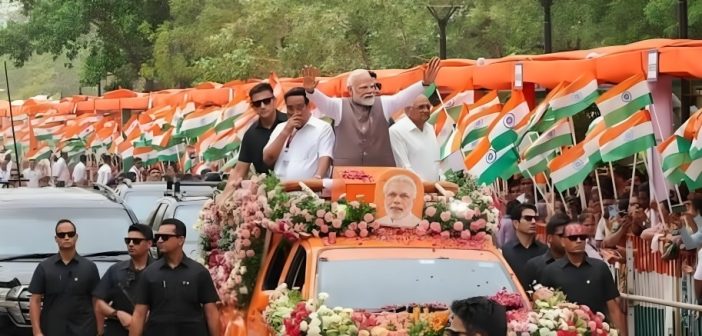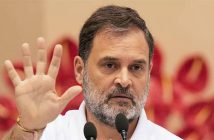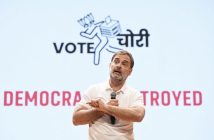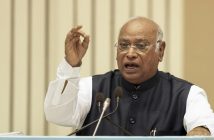As Bihar gears up for its 2025 assembly elections, PM Modi’s visit to Bihar in 2025 is a high-octane event, electrifying the political landscape. With development projects worth ₹48,000 crore unveiled, his strategic outreach to youth, women, and rural voters signals the BJP’s bold ambitions. But can Modi’s charisma outshine the RJD’s fiery counter-narrative and Nitish Kumar’s entrenched social base? The stage is set for a fierce electoral showdown.
Key Details
Prime Minister Modi arrived in Patna on May 29, 2025, to inaugurate the Jayaprakash Narayan International Airport’s new terminal and participate in a vibrant roadshow through the city’s bustling streets. The following day, he addressed a massive public gathering in Rohtas district, unveiling development projects worth over ₹48,000 crore, including infrastructure, rural electrification, and agricultural initiatives like the Makhana Board to boost Bihar’s superfood exports. Modi’s visit to Bihar, just months before the November 2025 elections, was strategic. Modi’s visit aimed to reinforce the NDA’s development agenda, cement alliances, and counter the opposition’s narrative of neglect and “Jungle Raj.” By choosing Patna and Rohtas—regions with symbolic resonance tied to governance and rural outreach—Modi signaled a focus on both urban and rural voters alike.
On May 29, 2025, Prime Minister Narendra Modi visited Bihar’s capital, Patna, for a whirlwind two-day visit that proved to be a masterstroke in electioneering. Against the backdrop of the looming Bihar Assembly elections, his third visit to the state this year was a calculated move to bolster the National Democratic Alliance (NDA). It was led by the Bharatiya Janata Party (BJP) and its ally, Janata Dal (United) (JD(U)). With a roadshow, a ribbon-cutting at Patna’s new airport terminal, and a mega-rally in Rohtas, Modi’s visit was a spectacle of development promises and political messaging. As the opposition Rashtriya Janata Dal (RJD) sharpens its social justice rhetoric, this visit underscores a pivotal moment in shaping voter sentiment and redefining Bihar’s electoral narrative.
Background: Bihar’s High-Stakes Electoral Battle
Bihar’s political landscape is a complex tapestry of caste dynamics, regional loyalties, and shifting alliances. The 2025 assembly elections, with 243 seats at stake, are a litmus test for the NDA, comprising the BJP, JD(U), Lok Janshakti Party (Ram Vilas), and Hindustani Awam Morcha (Secular). The BJP, now the single-largest party with 84 MLAs, has more than doubled its seat count since 2005, leveraging Modi’s national appeal and organizational prowess. However, Chief Minister Nitish Kumar’s JD(U), with 48 MLAs, remains a linchpin, commanding loyalty among women and Extremely Backwards Classes (EBCs) through welfare schemes such as bicycle distribution and self-help groups.
The opposition, led by the RJD under Tejashwi Yadav, is banking on its traditional Other Backwards Classes (OBC) and Muslim voter base, bolstered by promises such as ₹2,500 monthly aid for women and 200 units of free electricity. The RJD’s recent success in breaching Nitish’s Koiri voter base in the 2024 Lok Sabha elections has emboldened its campaign. Meanwhile, the Congress, aiming to assert itself as an “A team” rather than an RJD appendage, is pushing a caste census narrative to woo OBCs and EBCs, who form over 60% of Bihar’s population.
Key Events: Modi’s Strategic Outreach
PM Modi’s Bihar Visit 2025 is a carefully choreographed blend of symbolism and substance. The Patna roadshow, with cheering crowds waving BJP flags, projected unity and enthusiasm for the NDA. The inauguration of the airport terminal, named after the freedom fighter Jayaprakash Narayan, evoked Bihar’s historical pride while underscoring the state’s infrastructure development. In Rohtas, Modi’s rally emphasized rural progress. With announcements like the Western Koshi Canal project and the Makhana Board, which resonate with farmers and rural communities. His speech, laced with praise for Nitish Kumar as the “Ladla Chief Minister,” was a nod to alliance stability. Though the BJP’s reluctance to name Nitish as the NDA’s chief ministerial candidate sparked speculation.
Modi’s messaging targeted key demographics. For youth, he highlighted job creation through Digital India and gig economy initiatives, promising to register gig workers for government benefits. For women, he lauded JD(U)’s welfare schemes while promising further empowerment. Rural voters were wooed with agricultural schemes and infrastructure pledges, countering the RJD’s narrative of Bihar’s economic backwardness. “This is not just development; it’s a promise of Viksit Bharat,” Modi declared, framing the BJP as the architect of progress.
Stakeholder Perspectives
JD(U) leaders, like state president Umesh Singh Kushwaha, hailed Modi’s visit as a “golden period for Bihar,” emphasizing the ₹48,000 crore projects as proof of the NDA’s commitment. However, unease lingers within JD(U) over the BJP’s growing dominance, with 21 of 36 cabinet portfolios now held by the BJP. Nitish’s supporters fear a Maharashtra-style sidelining, where the BJP marginalized allies post-election. “Nitish is our face. The BJP knows its social base is irreplaceable,” said a senior JD(U) leader, requesting anonymity.
Allies and Opposition
The RJD, led by Tejashwi Yadav, launched a scathing counteroffensive. Yadav took to X, listing 15 questions for Modi, from Bihar’s low per capita income to the unfulfilled promise of special status. “The NDA has ruled Bihar for years, yet we’re still the poorest. Where’s the progress?” he posted, accusing Modi of empty promises. The RJD also criticized the timing of Modi’s April 24 visit, coinciding with national mourning for the Pahalgam terror attack, calling it an “undeclared emergency” to mobilize crowds.
The Congress, aiming to carve its own space, accused the BJP of undermining federalism. Bihar Congress leaders contrasted Rahul Gandhi’s decision to cut short his US trip during the Pahalgam crisis with Modi’s campaign focus. “The nation mourns, but Modi campaigns,” read a Bihar Congress post on X, amplifying public discontent.
Modi’s visit has energized BJP supporters, particularly in urban areas and among upper-caste voters, where his charisma remains potent. A C-Voter survey shows Tejashwi Yadav’s popularity dipping from 40.6% to 35.5% as a chief ministerial candidate, suggesting Modi’s rallies may be swaying undecided voters. Among young people, the promise of gig economy jobs and Digital India resonates, although unemployment remains a sticking point. Women voters, especially from OBC and EBC communities, continue to lean toward Nitish’s welfare schemes, but Modi’s emphasis on women’s empowerment is bridging the gap. Rural communities, influenced by agricultural initiatives, view Modi’s visit as a commitment to their livelihoods, although skepticism persists regarding its implementation.
The RJD’s focus on social justice and free services, such as electricity and women’s aid, appeals to its core base, but Modi’s development narrative challenges its momentum. “The BJP is selling dreams, but we’re offering real solutions,” Tejashwi told a crowd in Patna, signaling a fierce campaign ahead.
Venue Symbolism and Political Messaging
The choice of Patna and Rohtas was laden with symbolism. Patna, the political nerve center, amplified the NDA’s urban outreach, while the Jayaprakash Narayan Airport terminal invoked Bihar’s legacy of social reform. Rohtas, a rural stronghold, underscored Modi’s commitment to farmers and economically backward classes (EBCs), countering the RJD’s caste-based narrative by praising Nitish as “Ladla.” Modi balanced alliance dynamics while subtly asserting the BJP’s dominance. The absence of an explicit chief ministerial endorsement. However, keeps the door open for post-election maneuvering, signaling to voters that the BJP is the backbone of the NDA.
Broader Implications: Redefining the Electoral Landscape
Modi’s visit has reshaped campaign strategies. The BJP is doubling down on development and Hindutva, leveraging Modi’s appeal to expand its OBC and urban base. The JD(U) is wary of being overshadowed and is reinforcing its social welfare credentials. The RJD, buoyed by its 2024 Lok Sabha gains, is intensifying its social justice pitch, with Tejashwi positioning himself as a youth icon against Modi’s national stature. The Congress’s push for a caste census could realign OBC and EBC votes, complicating alliance arithmetic.
PM Modi’s 2025 Bihar visit also highlighted key voter concerns, including unemployment, caste dynamics, and infrastructure development. The BJP’s caste census decision, announced in 2025, aims to neutralize the RJD’s narrative but risks alienating upper-caste voters. Alliance stability remains a wildcard, with JD(U)’s anxieties and RJD’s outreach to smaller parties, such as the CPI(ML), shaping coalition prospects. Bihar’s 40 Lok Sabha seats make its assembly outcome pivotal for the 2026 national elections.
Conclusion
Prime Minister Modi’s May 2025 visit to Bihar has set the stage for a high-stakes electoral battle, blending development promises with strategic politicking. By targeting youth, women, and rural voters, the BJP aims to solidify its dominance while navigating alliance tensions with JD(U). The RJD’s aggressive counter-narrative and the Congress’s push for a caste census ensure a fierce contest. As Bihar’s voters weigh development against social justice, Modi’s visit may well be the spark that ignites the debate. The state’s 2025 election narrative, with ripple effects for India’s political future.
Dive into the unfolding Bihar election saga—stay updated on the latest political developments!




